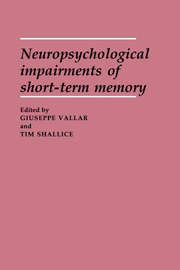Book contents
- Frontmatter
- Contents
- List of contributors
- Acknowledgments
- General introduction
- I THE FUNCTIONAL ARCHITECTURE OF AUDITORY–VERBAL (PHONOLOGICAL) SHORT-TERM MEMORY AND ITS NEURAL CORRELATES
- 1 The impairment of auditory–verbal short-term storage
- 2 The development of the concept of working memory: implications and contributions of neuropsychology
- 3 Multiple phonological representations and verbal short-term memory
- 4 Electrophysiological measures of short-term memory
- II PHONOLOGICAL SHORT-TERM MEMORY AND OTHER LEVELS OF INFORMATION PROCESSING: STUDIES IN BRAIN-DAMAGED PATIENTS WITH DEFECTIVE PHONOLOGICAL MEMORY
- III SHORT-TERM MEMORY STUDIES IN DIFFERENT POPULATIONS (CHILDREN, ELDERLY, AMNESICS) AND OF DIFFERENT SHORT-TERM MEMORY SYSTEMS
- IV PHONOLOGICAL SHORT-TERM MEMORY AND SENTENCE COMPREHENSION
- Name index
- Subject index
1 - The impairment of auditory–verbal short-term storage
Published online by Cambridge University Press: 11 May 2010
- Frontmatter
- Contents
- List of contributors
- Acknowledgments
- General introduction
- I THE FUNCTIONAL ARCHITECTURE OF AUDITORY–VERBAL (PHONOLOGICAL) SHORT-TERM MEMORY AND ITS NEURAL CORRELATES
- 1 The impairment of auditory–verbal short-term storage
- 2 The development of the concept of working memory: implications and contributions of neuropsychology
- 3 Multiple phonological representations and verbal short-term memory
- 4 Electrophysiological measures of short-term memory
- II PHONOLOGICAL SHORT-TERM MEMORY AND OTHER LEVELS OF INFORMATION PROCESSING: STUDIES IN BRAIN-DAMAGED PATIENTS WITH DEFECTIVE PHONOLOGICAL MEMORY
- III SHORT-TERM MEMORY STUDIES IN DIFFERENT POPULATIONS (CHILDREN, ELDERLY, AMNESICS) AND OF DIFFERENT SHORT-TERM MEMORY SYSTEMS
- IV PHONOLOGICAL SHORT-TERM MEMORY AND SENTENCE COMPREHENSION
- Name index
- Subject index
Summary
Introduction
Since the 1940s many theorists have suggested that information might be stored in the cognitive system in a different way over short time periods than for longer time periods. A number of possible mechanisms have been proposed – special or general-purpose buffers, the continuing but temporary activation of the structures that have just processed an input, and the formation of temporary associations or temporary changes in association strength. Theoretical arguments for such mechanisms have been produced from a range of scientific fields from physiological psychology (e.g., Hebb, 1949), information-processing psychology (Broadbent, 1958), and symbol-processing artificial intelligence (Newell & Simon, 1972) through to connectionist neuroscience (e.g., Crick, 1984; Hinton & Plaut, 1987). Empirical support has come from a narrower set of approaches. Most of the relevant findings have come from experimental psychology (e.g., Waugh & Norman, 1965; Atkinson & Shiffrin, 1968; Glanzer, 1972; Baddeley & Hitch, 1974), but these have been subject to many criticisms (see, e.g., Craik & Lockhart, 1972; Crowder, 1982).
From a neuropsychological perspective, if a short-term memory trace were being carried by certain of the aforementioned mechanisms, a selective deficit to that mechanism would be realized in a selective impairment in behaviour. This is clearly true for the most favoured possibility – damage to a specific short-term memory buffer - given that the buffer was not involved in all cognitive operations. It would also apply for a specific impairment of one of two association-weight-changing mechanisms. For instance, Hinton and Plaut (1987) have simulated a connectionist network using two types of weights – “slow” weights (which change slowly and carry the long-term learning) and “fast” weights (which change rapidly but decay fairly quickly to zero).
- Type
- Chapter
- Information
- Neuropsychological Impairments of Short-Term Memory , pp. 11 - 53Publisher: Cambridge University PressPrint publication year: 1990
- 71
- Cited by

